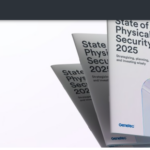Iris Biometrics Push Physical Security Beyond Keycards and PINs

Mohammed Murad, Vice President, Global Sales and Business Development, IRIS ID looks at the power of iris recognition and how it can secure data centres with biometric precision.
No firewall or encryption protocol can protect a data center if an unauthorized person gains physical access. While organizations invest heavily in cybersecurity, physical security remains an overlooked vulnerability — one that attackers increasingly exploit. In 2024, the average cost of a data breach soared to $4.88 million, a 10% increase from the previous year, according to the IBM Security Report. Yet, 68% of breaches involve human error, insider mistakes, or credential misuse, as found in the Verizon 2024 Data Breach Investigations Report.
For data centers — the backbone of global digital infrastructure — this risk is even greater. A stolen keycard, shared password, or compromised credential can bypass multiple security layers, granting an attacker direct access to critical systems. Traditional access controls, such as PIN codes and RFID badges, are increasingly ineffective. To counter these risks and with billions of records at risk, organizations are turning to biometric authentication, with iris recognition emerging as the most secure and scalable solution.
The growing security risks facing data centers
Data centers store and process vast amounts of sensitive data, making them prime targets for both cyber and physical attacks. Organizations focus heavily on preventing malware, phishing, and ransomware, but physical security remains a weak point. Cybercriminals and insider threats don’t always rely on hacking — sometimes, gaining physical access to a server room is enough to bypass even the most sophisticated cybersecurity measures.
According to Flashpoint’s Global Threat Intelligence Report, data centers experienced a 34.5% increase in physical security incidents in 2023, including unauthorized access, tailgating, and credential theft. More than 80% of data breaches involve stolen or misused credentials, highlighting the urgent need for stronger access control policies.
Traditional security measures, such as keycards, PIN codes, and fingerprint scanners, present their vulnerabilities. Keycards can be cloned, PINs can be share,d and fingerprint scanners often fail in environments where employees wear gloves and PPE. Meanwhile, social engineering tactics — such as phishing or impersonation — make it easier than ever for attackers to manipulate access controls.
Iris recognition: the new standard in data center security
Security leaders are seeking solutions that offer both stronger protection and operational efficiency. Iris recognition outperforms traditional access control methods, offering unmatched accuracy, speed, and compliance with global security regulations.
Unmatched accuracy and protection
Iris biometrics analyzes over 240 unique characteristics, delivering near-zero false acceptance rates. The National Institute of Standards and Technology (NIST) has confirmed that iris recognition surpasses fingerprints and facial recognition in high-security applications. Since no two irises are alike — not even in identical twins—it is virtually impossible to duplicate or spoof.
Non-contact, fast and reliable authentication
Unlike fingerprint scanners, which struggle in environments where personnel wear gloves or have wet or damaged skin, iris recognition works effortlessly, even with PPE, glasses, or face masks. This makes it an ideal solution for data centers with strict hygiene protocols and high employee turnover, curbing bottlenecks at security checkpoints.
Eliminating credential and insider threats
With 80% of breaches involving stolen or misused credentials, traditional keycards and passwords remain a security liability. Iris authentication ties access directly to an individual’s biological identity, eliminating the risk of shared, stolen or lost credentials. This is particularly critical in colocation data centers, where multiple organizations operate within the same facility, increasing the risk of unauthorized access.




















